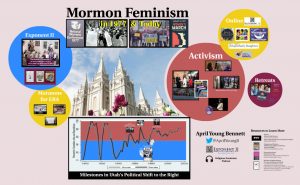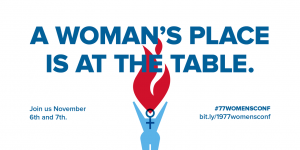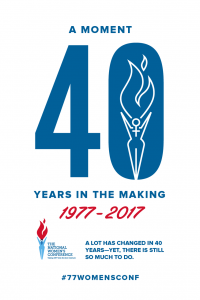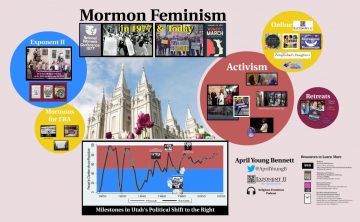This week marks the 40th anniversary the National Women’s Conference in Houston, Texas, a culmination of the International Women’s Year (IWY) celebrations in the 1970s. I recently went to Houston for the 40th anniversary celebration of this historic event and delivered this speech about how Mormons reacted to IWY back then and what Mormon feminism is like today.
Video: Mormon Feminism in 1977 and Today
Full Text:
Mormon Feminism in the 1970s

International Women’s Year in 1975 and the National Women’s Conference in 1977 took place at a pivotal time for Mormon women. In the 1970s, Mormon women began new feminist organizations and organized International Women’s Year events. Meanwhile, Mormon officials fought the Equal Rights Amendment and attempted to solidify traditional gender roles.
Founding of Exponent II
In 1970, Mormon women in Boston began a consciousness-raising group, similar to others of the women’s movement. One day, one of their members discovered a suffragist newspaper written by nineteenth century Mormon women and brought copies to their meetings. It was called the Woman’s Exponent. 1
Mormon women have a fraught relationship with our foremothers. Many of us still cringe when we think about their plight as wives of polygamists, but within the pages of the Women’s Exponent, we see another side to these women. They were among the first American women to achieve the right to vote and many were pioneers in fields such as medicine, politics, and manufacturing.
The Boston women began their own feminist newspaper in 1974, naming it Exponent II in homage. In its first issue, https://exponentii.org/wp-content/uploads/2021/12/IMG_5173-scaled-1.jpg Claudia Bushman declared that Exponent II to be “poised on the dual platforms of Mormonism and Feminism.” They aimed to show that feminism was compatible with Mormonism through both their words and their lives. 1,2 They reached 4,000 subscribers within their first year. 3
Mormon Politics through the 70s
I happen to be both a Mormon and a Utahn, but I can assure you that the two demographics are not synonymous. 45% of Utahns are not Mormon 4 and 87% of Mormons live outside of Utah. 5 However, as the only state with a Mormon majority, Utah’s political history is the closest indicator we have to how Mormon political opinions have shifted over time.
During its first several decades of statehood, both major parties were competitive in Utah. 6 Spikes in Republican support in Utah could often be traced to events transpiring in the Mormon community. For example, the Republican party was popular in Utah in the 1950s when Ezra Taft Benson, who was an apostle in the Mormon Church, simultaneously served on the cabinet of Republican president Dwight D. Eisenhower.
Within the Mormon Church, only fifteen men are called as apostles. They are the highest-ranking members of the Church and revered by Mormons as prophets, seers and revelators. All apostles are all men. The Mormon priesthood is male-only, with virtually every Mormon man and boy age 12 and up ordained to its lay clergy, while all women are banned from priesthood office.
When the Eisenhower administration concluded in 1961, Benson’s term on his cabinet came to a close and Utah politics returned to balance again, with another short-lived spike in Republican support in response to Roe vs. Wade in 1973. 6,7
Equal Rights Amendment
1973 was also the year that the Utah Legislature began considering whether to ratify the Equal Rights Amendment (ERA). It looked promising; polling showed that 65% of Utahns favored the ERA, including 63% of Mormons and 73% of other Utahns. 8
Conservative activist Phyllis Schlafly came to Utah in 1974 to lobby against the ERA and contacted Barbara Smith, who was president of the Relief Society, the Mormon Church’s organization for women. 8 Schlafly may have overestimated Smith’s authority. Although all Relief Society members are women, Relief Society presidents are not elected by women; they are chosen by male priesthood leaders who supervise them and they must receive permission from these male priesthood leaders for any initiatives.
Smith told Schlafly she didn’t think priesthood leaders would take a stand against the ERA because they only became involved in politics with regards to moral issues. However, after talking to Schlafly, Smith brought the question to the male leaders of the church and found that they did want to oppose the ERA. 8
They justified their involvement by declaring the ERA a moral issue after all, but their stated reasons for opposing it focused mainly on legal concerns such as “vague language” and its effects on “the constitutional division of powers.” 9
The night before Utah’s 1975 legislative session began, Mormon Church News published a statement in opposition to the ERA. Overnight, support for the ERA in the Utah House of Representatives dropped from 34 to 16. It was defeated by a 2 to 1 ratio. In the general public, the ratio of support for the ERA among Utah Mormons dropped to only 31%, while Utahns of other faiths continued to support the ERA by a two to one margin. 8
International Women’s Year
 1975 was declared International Women’s Year by the United Nations and as it came to a close, the United States Congress passed a bill calling for Americans to continue the work by organizing a National Women’s Conference, proceeded by smaller conferences in each state, to “identify the barriers that prevent women from participating fully and equally in all aspects of national life, and develop recommendations for means by which such barriers can be removed.” 11
1975 was declared International Women’s Year by the United Nations and as it came to a close, the United States Congress passed a bill calling for Americans to continue the work by organizing a National Women’s Conference, proceeded by smaller conferences in each state, to “identify the barriers that prevent women from participating fully and equally in all aspects of national life, and develop recommendations for means by which such barriers can be removed.” 11
Jan Tyler chaired Utah’s conference committee. She was a Mormon and a professor at Mormon church-owned Brigham Young University, but she was also a fervent supporter of the ERA. About half of the women on her committee were also Mormon women. 12,13 They wanted the Mormon Relief Society to be represented in the proceedings but were stunned when Ezra Taft Benson, the same Mormon apostle who had served on Eisenhower’s cabinet, instructed Mormon clergy to assign 10 women to attend the convention from every Mormon congregation in Utah. That meant that the Mormon church would be sending about 12,000 women, a number that would certainly out-vote anyone else in attendance. 8,12,14
Thanks to Benson’s directive, Utah’s state conference had the highest attendance numbers of all states, with 14,000 attendees, overwhelming Tyler and her committee, who had expected between 300 and 2,000 people. The much more populated state of California had fewer than half as many attendees as Utah, and California had held one of the biggest women’s conferences in the nation. 8,15
Conservative Mormons, many of whom also had leadership roles within local Mormon clergy, invited the Mormon women who were assigned to attend the conference to political planning meetings and told them to “vote no on everything.” The church didn’t technically endorse these meetings, but many of the Mormons who came didn’t know that. 8,13
When the conference opened, some of these women stationed themselves in front of contribution boxes to prevent other women from donating funds to the event. 12 Mormon women voted as a block against every item on the national platform, even the most uncontroversial and innocuous resolutions—just as they had been instructed to do at those planning meetings. 13,14,15 All of the delegates they elected to represent Utah at the national convention in Houston came from a list distributed by a conservative lobbying group. 8 At one point, an angry mob of Mormon women even dismantled the booth of the National Organization for Women. 15 When the conference closed, they refused to leave the venue until General Relief Society President Barbara Smith intervened. 12
Although Smith had become the church’s spokesperson in opposition to the ERA, she was dismayed by the mob mentality that had characterized Mormon women’s actions at the conference and regretted that she had not done more to reign in conservative lobbyists. 8
Mormons for ERA
Even so, the Mormon church continued to align with conservative and anti-feminist lobbying groups as they embarked on campaigns to prevent or rescind ERA ratification in several states. 10 In Virginia, some Mormons pushed back, starting an organization called Mormons for ERA to support ratification of the amendment. 3
Mormons for ERA lobbied and held marches in several states. 16 Sometimes, they hired airplanes to fly pro-ERA banners over Temple Square in Salt Lake City. 3,16
One of the founders of Mormons for ERA, Sonia Johnson, appeared before the Senate Constitutional Rights Subcommittee in 1978. 3 Johnson was excommunicated from the Mormon church by her bishop about a year after her testimony to Congress. 3 A bishop cannot excommunicate a Mormon man—only someone higher up on the chain of command has that authority. But bishops are allowed to excommunicate women.
While using excommunication to silence reformers hurts everyone, Mormon women are particularly vulnerable. Mormon women are disciplined by panels made up entirely of the opposite sex, are not permitted to read the rules and procedures by which they may be punished, and are not afforded the same protections that men enjoy. 17
Ironically, church leaders claimed that favoring the ERA was not grounds for excommunication. 9 Johnson’s bishop argued that he had not technically excommunicated her for her support of the ERA, but rather, for diminishing “support of church leaders.” However, the way she had supposedly diminished support for church leaders was by disagreeing with them about the ERA and successfully persuading others toward her opinion. 18 When Mormon leaders say that they do not be punish people for their opinions, they only mean that they don’t punish anyone for their private thoughts—and perhaps they would, if they could only read minds. Several Mormon activists, including me, have been warned by our church leaders that sharing our opinions is a punishable offense.
However, it would be infeasible to excommunicate every vocal Mormon. Instead, the church’s strategy has been to make an example of just a few of the most influential Mormons. 19 Ironically, excommunicating Mormon activists actually draws more attention to their ideas. Membership in Mormons for ERA doubled during the weeks following Johnson’s excommunication. 20
Mormon Feminism today
Mormon Politics Shift to the Right
The 1970s were the last decade in which Democrats were competitive in Utah. Prominent Republican Ezra Taft Benson became president of the Mormon church in 1985, ushering in a new spike in Republicanism in Utah. He would serve for nine years and after Benson’s presidency, political balance never returned to Utah nor to Mormonism generally. 6,7 Mormon feminists like myself, who were raised in the eighties and beyond, have only ever known our faith as the bastion of conservatism that it is today.
Blogs and Facebook Communities

Some wonder how feminism can exist within such a patriarchal environment. Actually, feminism thrives where it is needed most, so Mormonism is fertile ground for a feminist movement. The Mormon feminist organization Exponent II has continued to inspire Mormon women since its inception in 1970. Many of its original members from Boston continue to mentor younger Mormon feminists through the Exponent’s magazine, annual retreat and online communities and today, new generations of Mormon feminists have taken leadership roles in the organization. No longer limited to Boston, the Exponent community has expended to serve a worldwide network of Mormon women.
The Exponent is now joined by several other Mormon feminist communities, most centered around blogs and facebook groups. Thanks to the Internet, Mormon feminists from around the world can meet each other and discuss women’s issues. You don’t have to live in a progressive haven like Boston to be active in today’s Mormon feminist movement; online communities are the consciousness-raising groups of our era.
Retreats
But in-person interaction is important too. Within the United States, at least, Mormon feminists learn from each other and support each other in person at any of several retreats that take place each year in different parts of the country. Most of these retreats are limited to women, but one of my favorites, Feminist Mormon Girls Camp, welcomes whole families, including men and children. At this annual camp, our kids can earn merit badges for learning about feminism while grown-ups take turns leading feminist workshops or less serious crafts and games.
Activism
The scriptures teach that faith without works is dead 21 and I would argue that the same is true for feminism without activism. In recent years, Mormon feminists have demonstrated our need for a more egalitarian church through several activist events. For Mormon women, wearing pants to church is much more conspicuous than wearing an awareness ribbon. Although it’s a pretty tame act, when Mormon feminists decided to demonstrate by all of us wearing pants instead of dresses on the same day, at least one Mormon man was so peeved that he threatened violence. 22 Mormon feminist Nikki Hunter created a beautiful quilt from pants and other clothing worn by feminists that day.
Shortly thereafter, we campaigned to let women pray in General Conferences, our most important biannual religious meetings. Happily, Sister Jean A. Stevens did offer the first prayer by a woman at the next General Conference. 23,24
However, as long as Mormon women are banned from the priesthood, persuading men in power to change small and great inequities in the church one by one is an uphill battle for Mormon women. That is why I would argue that Ordain Women has been our most important activist initiative of this decade. Ordain Women has sponsored several actions, but none has attracted as much attention as our attempts to attend the male-only priesthood sessions of Mormon General Conferences. Hundreds of us marched to Temple Square, where we politely requested entry. We were not admitted, but we got noticed. 25
Unfortunately, church leaders retaliated in a familiar way—making an example of one influential Mormon woman. They excommunicated Kate Kelly, one of Ordain Women’s founders. 19 And history repeated itself in more than one way. Just as Mormons for ERA membership roles spiked following the excommunication of Sonia Johnson, after Kate was excommunicated, Ordain Women received an influx of new website profiles from Mormons who wanted women to be ordained. 26
Like the feminism of our foremothers, modern Mormon feminism looks beyond our own church. A new Mormons for ERA seeks to undo the damage our church did to the ERA in the seventies by getting the amendment passed now. 27
And Mormon feminists have been active participants and organizers in nondenominational feminist events such as the Women’s March. 28
As we work with other feminists, Mormon feminists sometimes encounter scorn from those who can’t understand why we don’t leave our patriarchal religion, as if simply abstaining from patriarchy is a more feminist act than combatting patriarchy. I remind them that religious sexism doesn’t only affect religious people. The success of the Mormon church at squashing the ERA is only one example of how religious patriarchy spills over into all areas of society, affecting the way people vote, work, and even how they think about the women that surround them on a day-to-day basis. Other feminists need the help of religious feminists to address one of the greatest barriers to success: the sexism people learn to tolerate at their places of worship. We’re making our own community and culture better, and that’s the first step to changing the world.
Resources to Learn More
Makers: Voices of Utah Women
Nancy Green, producer
Pedestals and Podiums: Utah Women, Religious Authority, and Equal Rights
Martha Sonntag Bradley, author
Mormon Feminism: Essential Writings
Joanna Brooks, Rachel Hunt Steenblik and Hannah Wheelwright, https://exponentii.org/wp-content/uploads/2021/12/IMG_5173-scaled-1.jpgs
The Birth of Ordain Women: The Personal Becomes Political
Lorie Winder Stromberg, author
Available within Voices for Equality: Ordain Women and Resurgent Mormon Feminism, edited by Gordon Shepherd, Lavina Fielding Anderson and Gary Shepherd
References
- https://exponentii.org/exponent-birthrebirth-series-mother-and-model-the-womens-exponent-by-claudia-bushman/
- https://archive.org/details/exponentii11arli
- Mormon Feminism Essential Writings. Joanna Brooks, Rachel Hunt Steenblik and Hannah Wheelwright, https://exponentii.org/wp-content/uploads/2021/12/IMG_5173-scaled-1.jpgs. Oxford University Press: 2016
- http://www.pewforum.org/religious-landscape-study/religious-tradition/mormon/
- http://www.mormonnewsroom.org/facts-and-statistics/ & http://www.mormonnewsroom.org/facts-and-statistics/country/united-states/state/utah [accessed October 2017]
- http://utahdatapoints.com/2014/11/update-the-2015-legislature-will-be-utahs-2nd-most-republican-since-the-depression/
- https://www.Mormon.org/manual/presidents-of-the-church-student-manual/ezra-taft-benson-thirteenth-president-of-the-church?lang=eng
- Pedestals and Podiums. Martha Sonntag Bradley. Signature Books: 2005
- https://www.Mormon.org/ensign/1980/03/the-church-and-the-proposed-equal-rights-amendment-a-moral-issue?lang=eng
- http://www.nytimes.com/1979/11/26/archives/many-mormon-women-feel-torn-between-equal-rights-proposal-and.html?mcubz=3
- https://www.gpo.gov/fdsys/pkg/STATUTE-89/pdf/STATUTE-89-Pg1003.pdf
- https://www.sunstonemagazine.com/pdf/008-11-14.pdf
- https://www.dialoguejournal.com/wp-content/uploads/sbi/articles/Dialogue_V11N01_60.pdf
- http://www.nytimes.com/1977/07/25/archives/mormon-turnout-overwhelms-womens-conference-in-utah.html
- http://www.pbs.org/video/utah-history-makers-voices-utah-women/
- http://exhibits.usu.edu/exhibits/show/mormonsforera/mormonsforerastanceonera
- Most disparate church discipline policies differentiate between men with the Melchizedek priesthood and other church members. Virtually all men who have been active Mormon church members for any portion of their adult lives are ordained to the Melchizedek priesthood. All women are banned from the Melchizedek priesthood. Hence, with a few exceptions, these policies discriminate solely on the basis of sex. The policies are written in Church Handbook of Instructions Volume 1. Access to this volume is restricted to Mormons rotating through certain lay clergy positions, nearly all of which exclude women. The author accessed the policies through a leaked copy of the 2010 edition.
- https://www.washingtonpost.com/archive/politics/1979/12/06/mormon-bishop-excommunicates-woman-who-is-supporting-era/2194cbc1-806e-4014-8884-d1a527620a3f/?utm_term=.190c571517af
- https://www.theguardian.com/world/2015/feb/06/lds-church-mormons-apostasy-excommunication
- http://people.com/archive/sonia-johnsons-excommunication-by-the-mormons-cut-the-big-string-that-held-her-marriage-together-vol-13-no-6/
- James 2:20
- http://www.nytimes.com/2012/12/20/us/19mormon.html?_r=0
- http://archive.sltrib.com/article.php?id=56116507&itype=CMSID
- https://news.hjnews.com/news/woman-leads-closing-prayer-at-mormon-conference/article_f0207c64-9eea-11e2-834b-001a4bcf887a.html
- https://www.theatlantic.com/national/archive/2014/04/the-movement-to-ordain-mormon-women/360533/
- http://www.sltrib.com/opinion/commentary/2015/01/24/op-ed-ordain-women-supporters-are-worthy-of-their-congregations-love
- https://www.youtube.com/watch?v=67wqc7trung
- https://exponentii.org/mormon-women-march/








11 Responses
It should be noted that Sonia Johnson was excommunicated for apostasy, specifically putting out the word to others (in a television interview) to NOT let missionaries in the door if they come knocking.
That action — actively impeding the missionary program — constituted apostasy on her part sufficient for her disciplinary council (then-called a ‘church court’).
It’s important to remember that no bishop can convene a disciplinary council without consent of the stake president. This is for three reasons:
1. It lets the SP know things have reached a point in the member’s life, that despite working with the member, no alternative remains in helping them remain focused on God and Christ as the center of their lives;
2. It serves as a check and balance on a power-tripping bishop who has run amok with power and out-of-control ego; and
3. It protects the Church from potential liability because proper procedures designed to protect both member, leader AND the Church wasn’t followed.
Sonia (her case only) simply used it as her reason to leave, which she wanted to do anyway, as it turned out some years later.
Last I heard, she and her partner were running a bed-and-breakfast somewhere in the Southwest.
I hope she finds her peace. ***
Tim:
Johnson made it very clear in numerous interviews that she did not instruct nonmembers to bar the missionaries, but rather made the prediction that a natural consequence of the church’s political stance would be that nonmembers would be less likely to speak with missionaries.
Johnson also made it clear that she did not want to leave the church at the time she was excommunicated. If she found happiness afterward in the life that was forced on her, I am happy for her, but that doesn’t change the facts of the case at the time it happened.
This is fantastic, April. I learned a lot, as I always do from your research on church history and feminist history. I didn’t know about Phyllis Schlafly’s role in getting Mormons on board with her anti-ERA politicking. It’s kind of heartbreaking to see women being tools to their own disadvantage like that.
Great article – Sonia Johnson was made my great aunt, and you definitely did her justice. Thank you.
The political shift to the right by mormons predates the sustaining of President Benson. It started with the election of President Reagan in 1980 after abysmal leadership by democrats on the national level. The general prosperity of the nation and the ascension of President Benson worked together to solidify mormon politics with the GOP.
There is a major opening now for non-GOP politicians to make in roads with mormons since the questionable Donald Trump is now the party leader. Nominating the well known and equally loathsome Hillary Clinton was not the step to start breaking down the GOP leanings of most church members.
Keep up the good history articles.
Most of the rights that women connected with the ERA seem to have been realized in society. There were many fewer barriers by 1980 than there had been 20 years earlier, and today there are virtually no real barriers that require new laws, let alone a constitutional amendment to address.
Alice Paul noted in 1923, “We shall not be safe until the principle of equal rights is written into the framework of our government.” She knew, like others who have researched the issue, that “Unless we put into the Constitution the bedrock principle that equality of rights cannot be denied or abridged on account of sex, the political and judicial victories women have achieved … for over two centuries [equal pay for equal work, for example] are vulnerable to erosion or reversal at any time — now or in the future.”
(See http://www.equalrightsamendment.org/why.htm)
Yes- if there is little to no change that the ERA will make, why not add it in even if it is only for formality?
April this is wonderful. As always, great research. So glad you’re part of Exponent.
This is great, April. This line in particular made me chuckle with how spot on it is: ” When Mormon leaders say that they do not be punish people for their opinions, they only mean that they don’t punish anyone for their private thoughts—and perhaps they would, if they could only read minds.”
Doubtless you are correct. They would if they could.
Good piece, April. Thanks for being a consistent, reasoned and articulate voice for gender equity in the Mormon community and beyond.
“vote no on everything.”
Reading this breaks my heart this morning. These men did not care about what was going on. There were surely some initiatives- I would guess the vast majority of them, that these men would agree were good things. They didn’t even care enough to educate themselves about these initiatives, but still took it upon themselves to tell the women what to do.